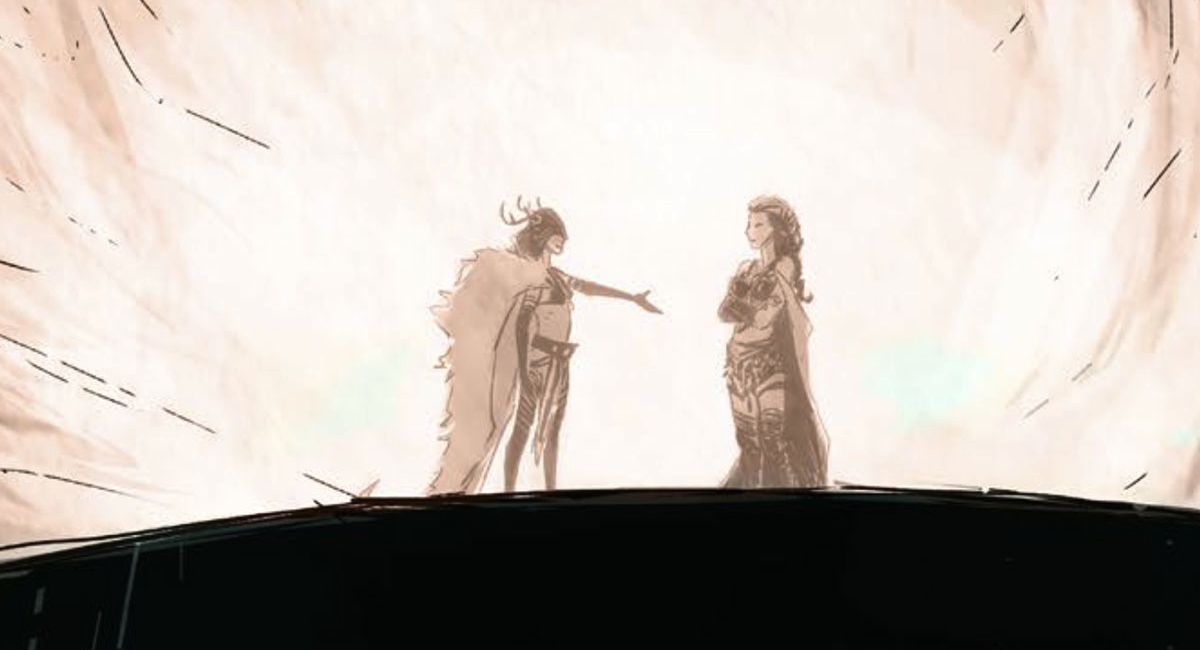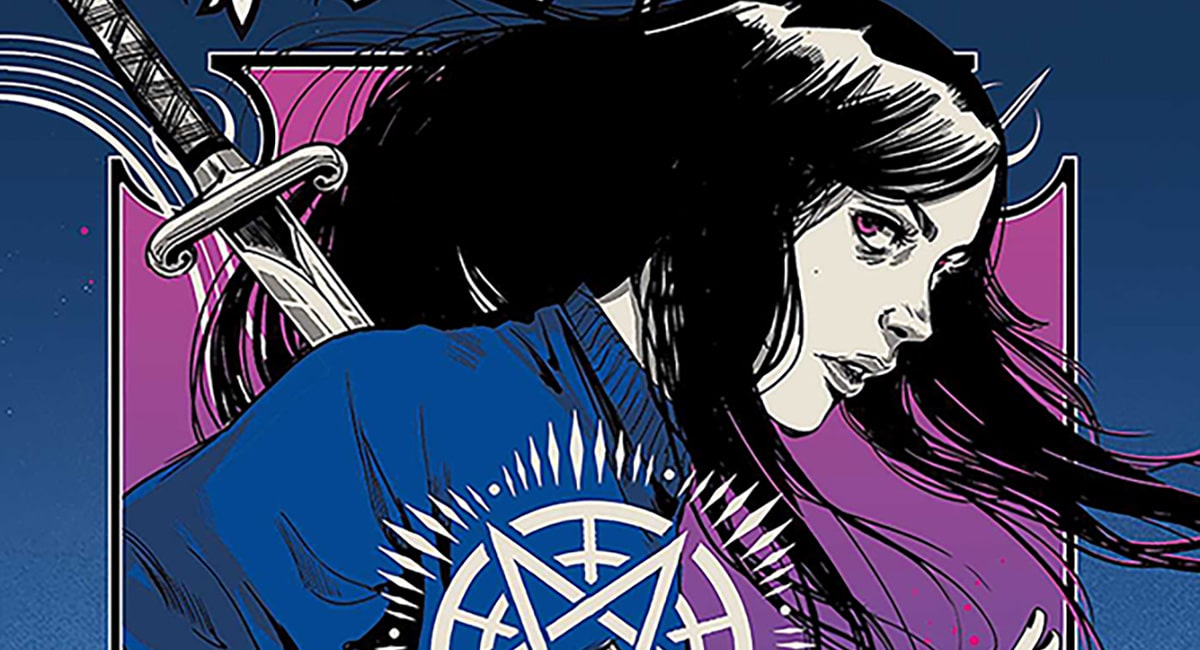Welcome to Queerness in Comics, a bi-weekly column by Avery Kaplan, which will explore queer representation and themes in comics. This week, Avery is exploring Heathen: Volume One, originally published in 2017.
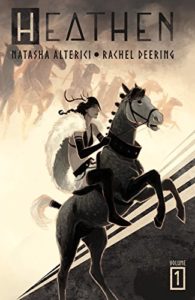
Letters: Rachel Deering
Covers: Tess Fowler & Tamra Bonvillain
Variants: Natasha Alterici, Jen Bartel, Nathan Gooden
Publisher: Vault Comics
Heathen is the story of a Viking warrior named Aydis who has been exiled from her village because she’s gay. When she is introduced in the first issue, she and the woman she had been caught kissing meet in the woods, after their respective punishments have been meted out.
However, both Aydis and Liv have been given different punishments for the same “crime” (kissing another woman, once). According to custom, their respective fathers are given an ultimatum: they must decide if their daughter will be married to a man or executed.
Liv’s father decides that she will be betrothed, and when Liv and Aydis meet early in the first issue, Liv has unfortunately internalized the implications of the nightmarish punishment that has been doled out to her: not only does she defend the decision to penalize them for their kiss, she claims that the kiss itself was “unnatural.” Perhaps worse still, Liv says that she thinks being forced to marry a man and being taken away on his ship might “fix her.”
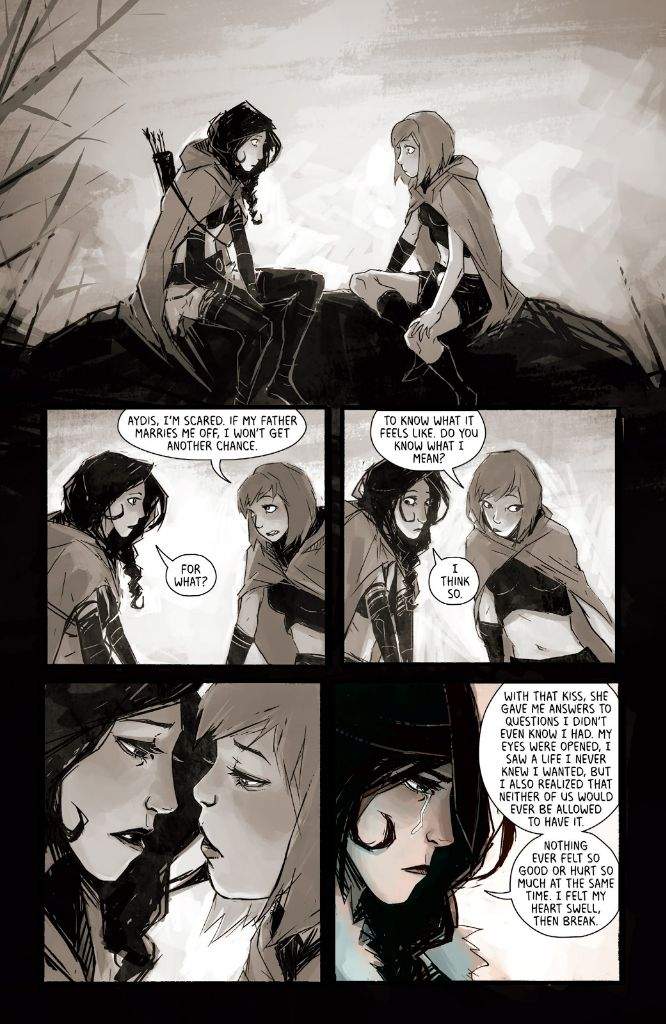
As Aydis tells her, there is nothing wrong with her. Nevertheless, while Aydis respects her decision to remain a part of the community and marry the man she is betrothed to, Aydis herself follows a different path.
Sins of the Father
In issue 2, we see a flashback to the day punishment for the indiscretion is doled out. When faced with the decision to either marry Aydis to a man or to personally execute her, her father lies to the Elders’ faces, telling them that he has elected to murder his daughter because she kissed a woman.
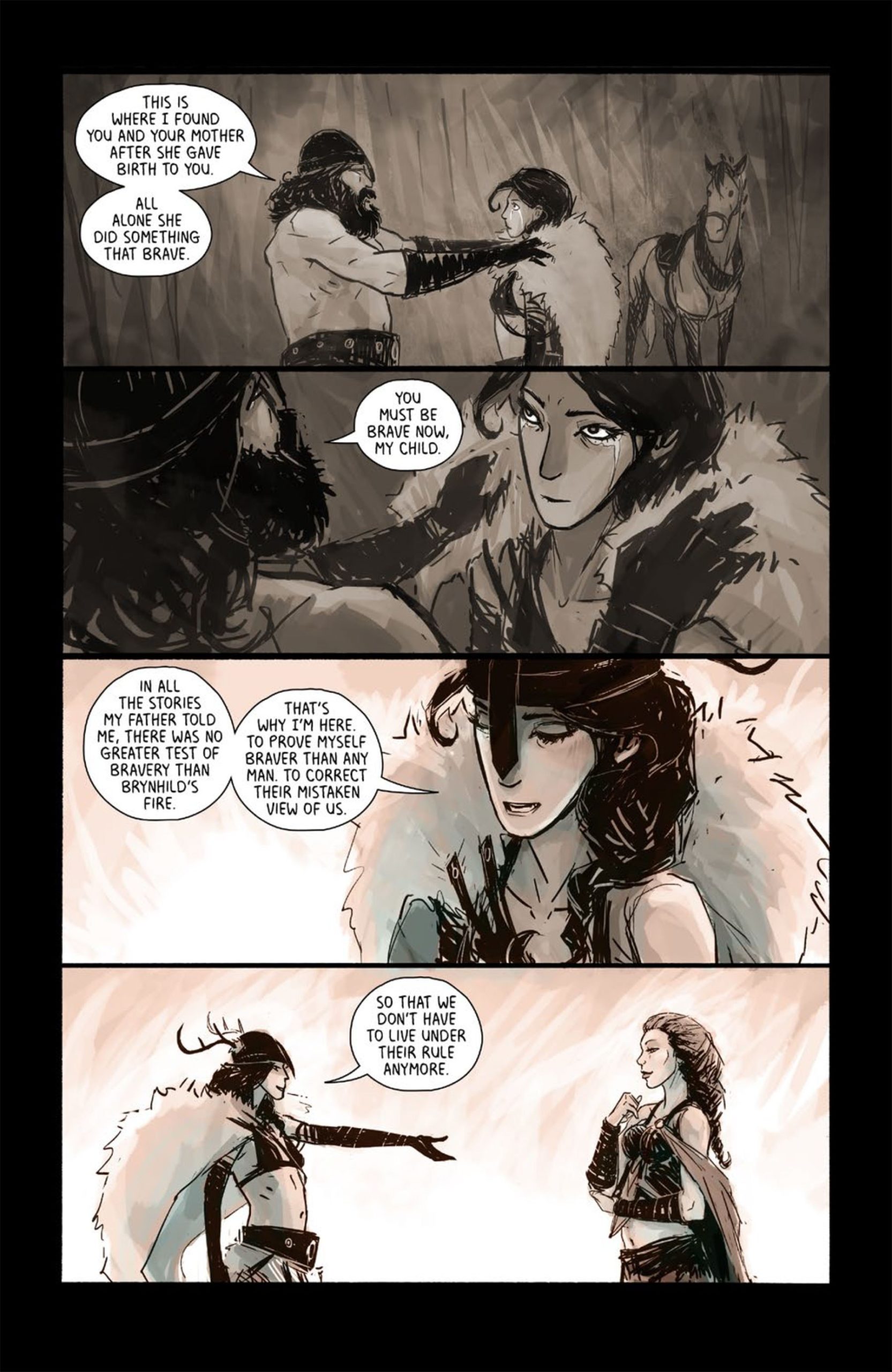
As Aydis tells the story, she admits that she almost believed the lie herself. Instead of murdering her, however, her father takes her to the place in the woods where her late mother birthed her and releases her. Her father tells her that she must be brave, continuing on alone, in exile from their home.
When Liv encounters Aydis in issue 1 after Aydis has been exiled, Liv calls her former lover a ghost, and in one sense, that’s extremely accurate. While Aydis was spared execution by her father, her exile from her village is nevertheless a kind of death – however, she is not precisely a ghost, because the exile is also a rebirth.
Rebirth
At the climax of the first issue, Aydis comes upon the carcass of a buck. She skins it and harvests its antlers, fashioning a horned helmet that she then dons on an arresting splash page. As she fashions the hat, her internal dialogue describes her decision to embark on a quest to free Brynhild, the Valkyrie exiled to a prison of flame atop Mount Hinderfall. According to the edict of Odin, Brynhild is to remain in exile until a mortal man frees her and claims her hand in marriage – a punishment not so different than the one doled out to Liv and Aydis.
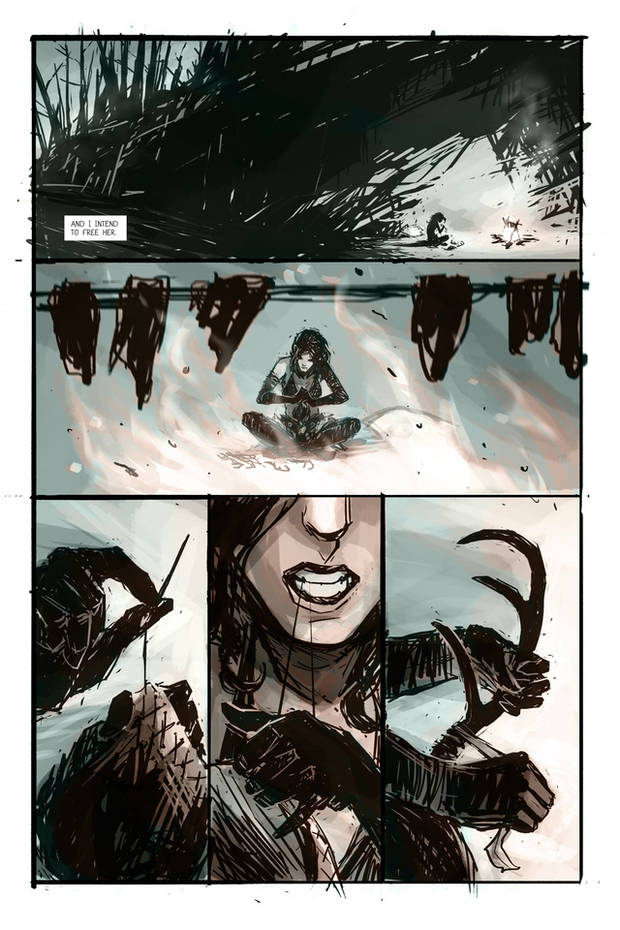
When Aydis arrives at the summit of the mountain in issue 2, Brynhild’s first interaction with the warrior is to assess the helmet that Aydis crafted near the conclusion of the first issue. While Brynhild admires the needlework and declares the helmet to be a classic example of the headgear worn by the northern seafaring people, she notes that the antlers are something of an aberration: as Brynhild notes, Vikings do not have helmets adorned with horns.
Aydis explains that the antlers are an affectation that she appropriated from the lies that have been spread about her people by the Christians from the southern lands. When the Christians learned that the Vikings worshipped other gods, Aydis explains to Brynhild, they began to create depictions of the Vikings that showed the warriors with horns on their head – suggesting that the Vikings were analogous to “the demons of their religion.”
The horns are therefore used to denote that the Vikings are heathens. However, by embracing the symbol and affirmatively claiming it as her own by fashioning her own helmet using the antlers, Aydis embraces the power that comes with being labeled demonic.
But the horns also differentiate Aydis from the rest of the Viking community, so thoroughly that Brynhilde immediately remarks on the fact that they are uncharacteristic of the Vikings. This is a physical, visible symbol of the fact that Aydis has been exiled from her people: she no longer belongs among them, and her helmet ensures the beholder is immediately cognizant of this fact.
The Power of Symbols
In issue 4, Brynhild comes upon a village in turmoil. She discovers that the villages have turned against a witch, predominantly because one of the young men in the community has claimed that she summoned a demon to possess him.
Brynhild separates the witch from the angry residents and then listens to her side of the story: the young man was gay, and came to her hoping for a “cure” for his “unnatural” condition (the echo of the word “unnatural,” which was used by Liv to describe her mutual attraction with Aydis, must be intentional).
Knowing that there was no cure for being gay, the witch thought to soothe his pain not by “curing” him, but by arranging a secret, regular tryst for him with a gay man from another nearby settlement. However, when the villages nearly discovered the truth about the young gay man, he elected to lie and claim that the witch had summoned a demon to possess him rather than reveal the truth.
Brynhild dons the helm given to her by Odin: the god-king gave each of the Valkyries this headgear, to serve as a symbol of the authority he vested in each of them. And the power imparted by this symbol is what Brynhilde uses to quell the rage of the villagers: she uses the authority imparted by the helmet to extend protection over both the falsely accused witch and her confused and fearful accuser.
However, while Brynhilde does use the authority symbolized by the helmet for good – protecting the innocent witch and her misguided accuser, who is himself a victim of the same societal machinations that plague Aydis – she nevertheless rejects the helmet at the conclusion of issue 4. She declares that she no longer wishes to be bound by Odin’s authority, connected to his power, or at the mercy of his permission: she wants power all her own, without having to answer to anyone else.
Reincarnation
It is for similar motivations that Aydis chooses to craft the horn-adorned helmet. By incorporating Christian demonic imagery into the helm, she has laid claim to power that would otherwise have been used to demonize her. Furthermore, the fact that she crafts the helm with her own two hands is meaningful, as well: while the basis of the headgear might be a standard design for the Vikings, this particular example is borne entirely from the warrior’s own labor.
The fact that when many people picture Vikings they imagine a helmet similar to the horned design worn by Aydis is a delicious subversion of centuries of Christian demonization: while Brynhilde identifies the horns as an anomaly, for most readers, it will immediately symbolize that Aydis is a Viking warrior.
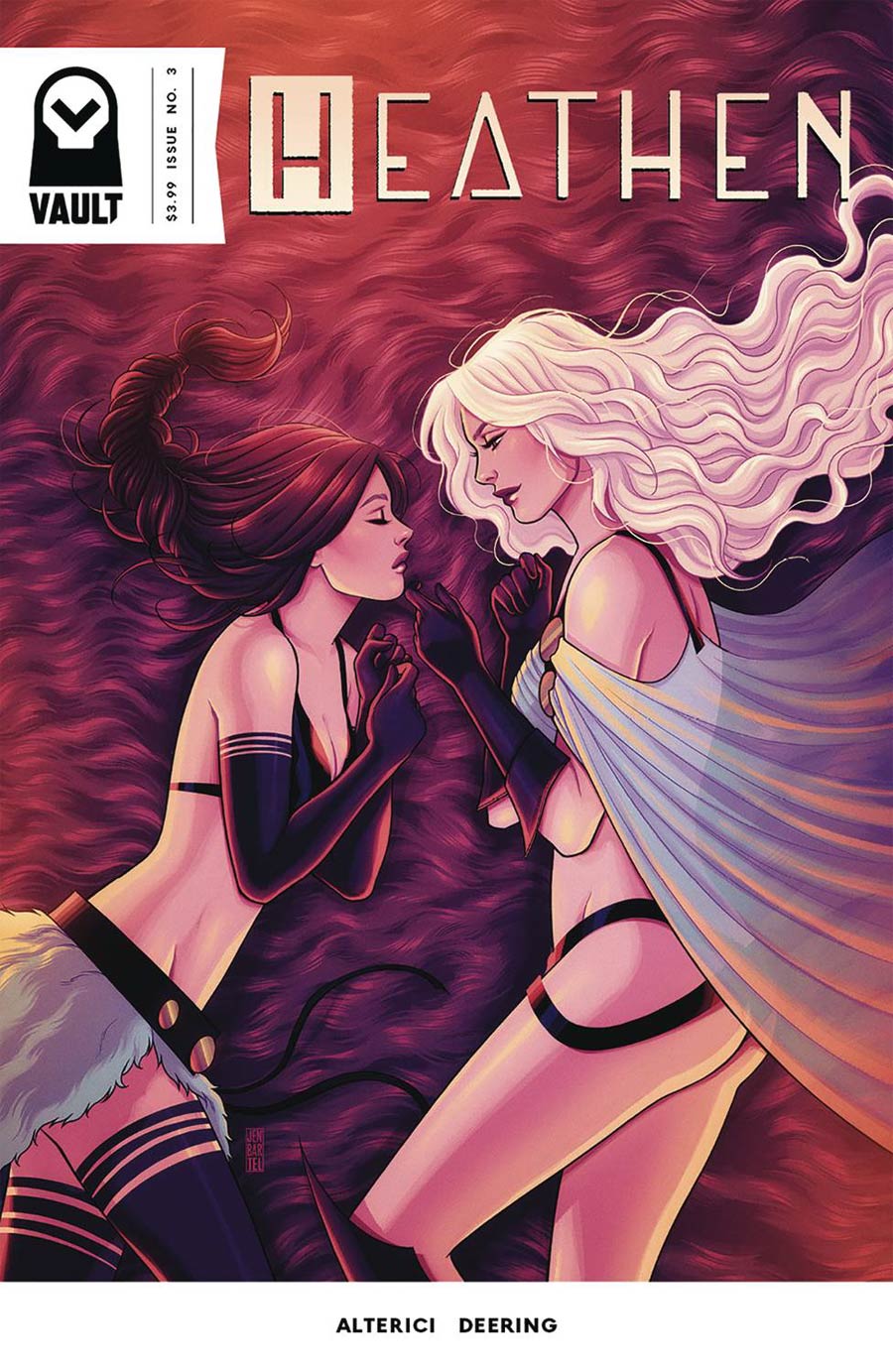
Find Heathen: Volume One and the continuing adventures of Aydis at your local library or comic book shop today, or check out the Tapas adaptation of the comic for mobile.



